In the Pacific Ocean, green sea turtles (Chelonia mydas) have an enormous range that can reach as far north as the southern coast of Alaska and as far south as the remote reaches of Tasmania. However, in Hawaii, a distinct subpopulation of Pacific green turtle exists. Their range has been shown to be very precise, as they travel some 600 kilometers to the northwest in order to nest at the protected French Frigate Shoals, the largest atoll in the Leeward Hawaiian Islands. They then return to the Southeastern Windward Hawaiian Islands to forage among the shallow, productive reefs of the archipelago.
The Turtle Arches Reef off the southern coast of Maui is a well-utilized coastal foraging ground among Pacific green turtles. A unique characteristic of this reef is the abundance of coral and benthic vegetative growth superposed upon submerged lava flows, tubes, and arches. This is an important feature because green turtles are herbivores and require a high proliferation of either benthic algae or seagrass. In addition to supplying the green turtles with food resources, underwater lava flows, like those pictured at Turtle Arches Reef, have been geologically formed to offer sea turtles adequate resting sites and refuge areas.
(Photograph & caption by Chris Makowski, Coastal Education & Research Foundation, West Palm Beach, Florida, USA)
* For more information on Hawaii's coral reefs, please refer to the following JCR article:
Calhoun, R.S. and Field, M.E., 2008. Sand composition and transport history on a fringing coral reef, Molokai, Hawaii. Journal of Coastal Research, 24(5), 1151–1160.






